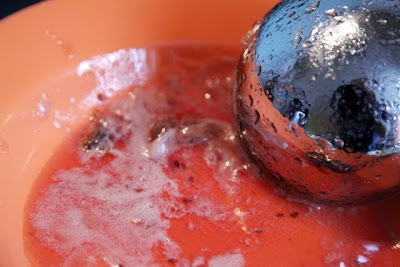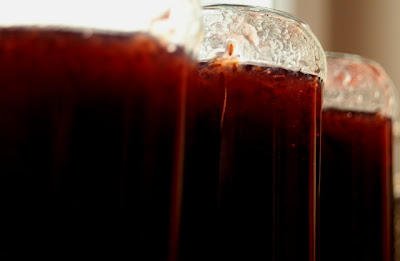Of late we have probably been eating about 2kg of cherries a week. The funny thing to a non-Polish person is that there really isn't just cherries. They have two, maybe four, maybe more depending on who you ask, types of cherries. The most obvious distinction, and one that is acknowledged by all Poles, is that there are early and late cherries. The early are not really considered as important as the late. The early cherries can tend to be less flavoursome as they are full of the spring and early summer rains. Of these you really get two varieties which are the standard red and the lighter almost white. Funnily enough the red seems to come to the market first. The later and darker red cherries are the best for jams and preserves and may be why they are more loved by the Poles as a whole. As an Australian, I am just happy to be buying them for 10PLN, 2.4Euro, 3.4AUD, 3USD, or 2GBP. Especially when I think back to Christmas time in Australia and how the price would regularly be over $20, I am just in heaven. I just came up with a little brain wave... we might try and grow a bonzai cherry tree.... I am sure it can be done!
So apart from swimming in red fruits, cherries, strawberries and the most amazing raspberries, I have found a berry that I previously really didn't know anything about, the Agrest. Nothing more ,of course, than when my father said to me as a child "Stop being a gooseberry", when I would follow my sister and her friends around, funny also that my father would pronounce it goozberry rather than gooseberry too. Of course to my Polish friends that phrase is something my Dad would say when he meant stop being the third wheel, the extra unwanted person. From this I always thought of Gooseberries as being unwanted and kind of sad fruits. That was until we bought some at the market. We bought a punnet which is about half a kilo and brought them home, some were green, some were a little red and some totally red. I tried them in each form. I must admit after trying the red one first and moving to the green I thought maybe there was a reason that gooseberries should be left alone.
 They do certainly look like something I would want to eat.
They do certainly look like something I would want to eat.
I started to do a little net surfing about my new purchase and came to realise that these little oval berries are actually very high in pectin, the one thing that the old Strawberry jam I made lacked. So I thought, hey, let's have a crack at making some jam! I went and bought another half a kilo of only green berries and got to it. First things first of course...... a recipe!
Gooseberry Jam
Seemed an easy and very straight forward one. So I started. First of all is to top and tail them removing the hard stalks, which is easy, but rather time consuming. Now while you have time and remember, put a plate into the freezer. Just a normal ceramic one, and also throw your cleaned jars into the oven at 140 or so for anything over 40 minutes to keep them sterile.
1. To every 450g prepared fruit use 300ml water. The riper the fruit, the less water you will need. Put the fruit and water into a large, heavy-based saucepan. Bring to the boil, then simmer gently until the skins are soft – they will not soften after the sugar has been added. Mine were half and half so I went in the middle with weights and water.
They kind of look like marbles in water here.
2. Use 450g-550g granulated sugar per 450g of fruit – use the larger amount for under-ripe fruit. Add the sugar and stir over a low heat until it has dissolved completely. If you boil the jam before it has dissolved, it may crystallise during storage.
 Even though I only had about 35-40% red or reddening fruit, I still ended up with a really dark jam.
Even though I only had about 35-40% red or reddening fruit, I still ended up with a really dark jam.
 Bring the jam to a rapid but steady boil and boil until it reaches a temperature of between 105°C and 110°C.
Bring the jam to a rapid but steady boil and boil until it reaches a temperature of between 105°C and 110°C.
Do the 'wrinkle test' to see if you have reached setting point. It should happen after about 15 minutes or so of boiling, and your jam should by now have become slightly more viscous and clear. Have a saucer ready in the freezer. Take the pan off the heat, spoon a little jam onto the plate and leave until completely cold. Then push it across the plate with your forefinger. It should wrinkle up if it's ready. If it only slightly wrinkles, bring back to the boil and boil for a few more minutes.
 When you take the scum off, just keep it on the side. There is nothing wrong with it, it is just not as "pretty" as the other jam. But it still tastes darned good on fresh bread with butter!
When you take the scum off, just keep it on the side. There is nothing wrong with it, it is just not as "pretty" as the other jam. But it still tastes darned good on fresh bread with butter!
Discard any scum from the top of the jam and pour it into the prepared jars, using a jam funnel. Cover the surface of the jam with waxed discs, wax-side down, and either quickly cover each jar with a dampened round of cellophane and rubber band or leave to go cold before covering with cellophane or a screw-top lid. Sealing the jars well will prevent the build up of condensation under the lid, which could lead to mould
 I like to put the jars upside down to make sure the seals are fine. Funny thing with a pectin rich thing like gooseberry jam is that the jam doesn't want to come back down again! Oh well, probably it will form a better seal against mould this way!
I like to put the jars upside down to make sure the seals are fine. Funny thing with a pectin rich thing like gooseberry jam is that the jam doesn't want to come back down again! Oh well, probably it will form a better seal against mould this way!
This jam still came out a little sweeter than I had hoped, I really wanted something with some tart. I might try again with just green fruit later in the summer. Or maybe still, the next exciting chapter will be blueberries, just coming into the market now at 20PLN a kilo! It is a steal, I feel like I am robbing them at that price!

No comments:
Post a Comment